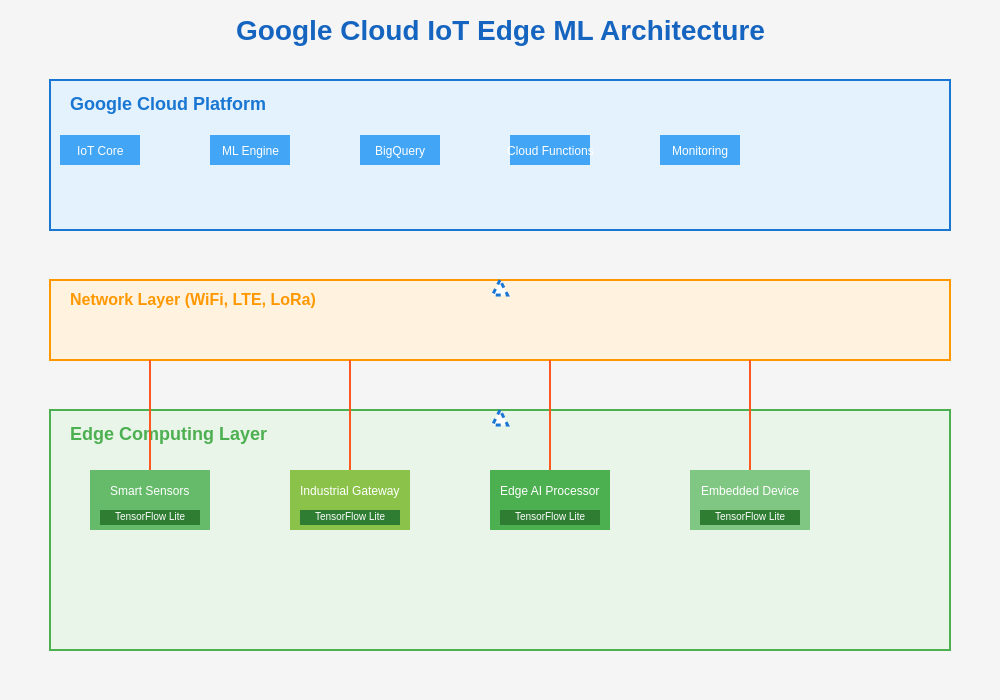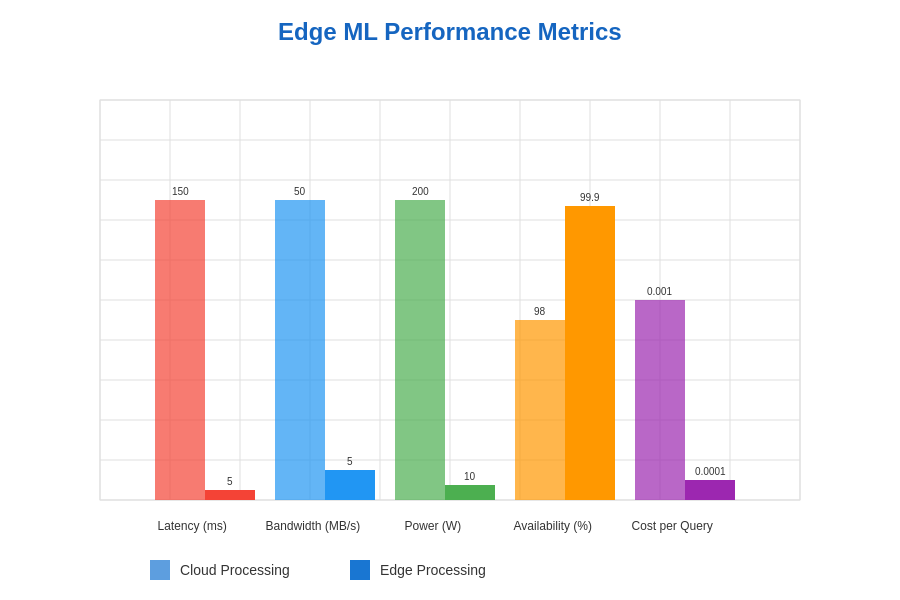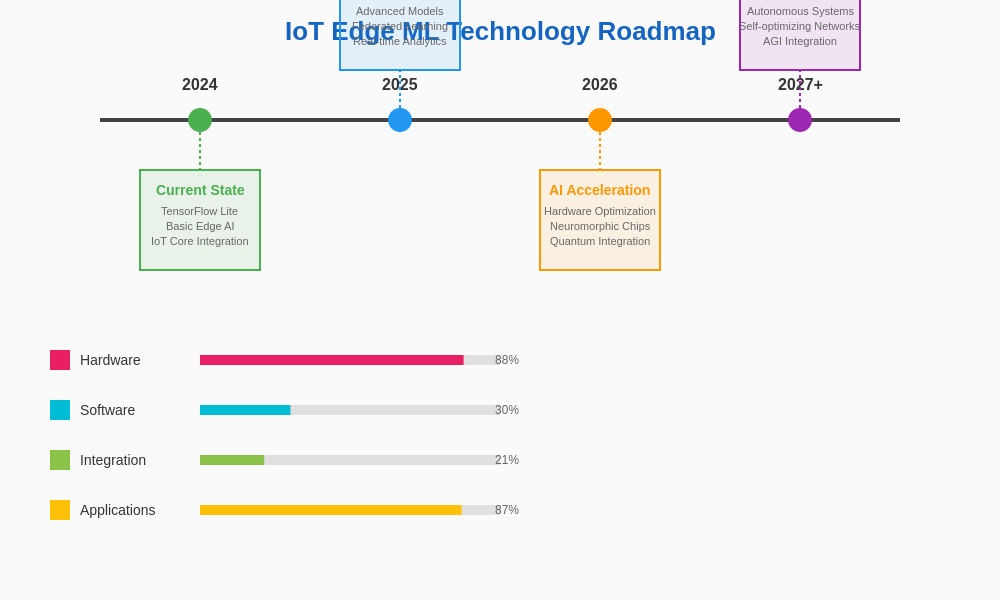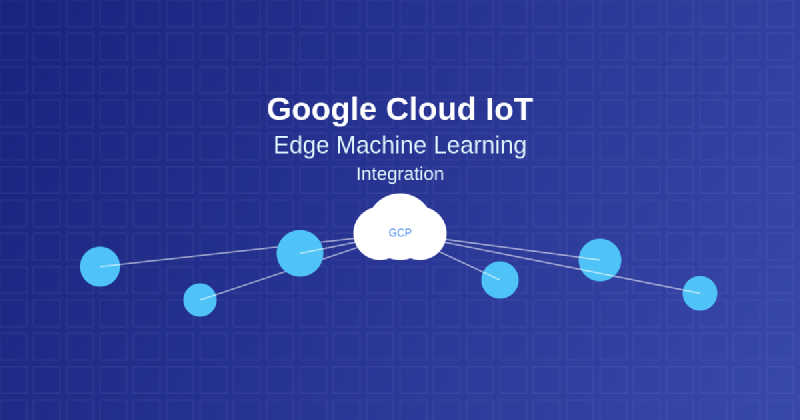The convergence of Internet of Things technology with machine learning capabilities at the edge represents one of the most transformative developments in modern computing infrastructure. Google Cloud IoT’s sophisticated integration with edge machine learning has established new paradigms for real-time data processing, intelligent decision-making, and autonomous system operation that fundamentally reshape how organizations approach distributed computing architectures and smart device deployments.
Explore the latest AI trends and innovations to understand how edge computing and machine learning are driving the next generation of intelligent IoT solutions. The seamless integration of cloud-based orchestration with edge-based inference creates unprecedented opportunities for organizations to deploy sophisticated AI capabilities directly where data is generated, eliminating latency concerns while maintaining robust connectivity to centralized cloud resources for model management and system orchestration.
Revolutionary Architecture of Edge-Cloud Integration
Google Cloud IoT’s approach to edge machine learning integration represents a sophisticated architectural framework that bridges the gap between centralized cloud computing power and distributed edge intelligence. This hybrid architecture enables organizations to leverage the computational resources of Google’s cloud infrastructure for complex model training and management while deploying lightweight, optimized inference engines directly on edge devices for real-time decision-making capabilities.
The architectural foundation centers on Google Cloud IoT Core’s ability to securely connect, manage, and ingest data from globally distributed edge devices while simultaneously coordinating the deployment and management of machine learning models across diverse hardware configurations. This approach ensures that edge devices can operate autonomously when connectivity is limited while maintaining seamless integration with cloud-based analytics, model updates, and centralized monitoring systems.
The integration extends beyond simple data collection to encompass sophisticated model lifecycle management, where TensorFlow Lite models are automatically optimized for specific edge hardware configurations and deployed through secure channels that ensure both performance efficiency and data security. This comprehensive approach enables organizations to maintain consistent AI capabilities across diverse deployment scenarios while adapting to varying computational constraints and connectivity patterns.
TensorFlow Lite Integration and Optimization
The cornerstone of Google Cloud IoT’s edge machine learning capabilities lies in its deep integration with TensorFlow Lite, Google’s lightweight machine learning framework specifically designed for edge deployment scenarios. This integration enables the seamless conversion of complex TensorFlow models trained in the cloud into optimized representations that can execute efficiently on resource-constrained edge devices while maintaining acceptable accuracy levels for real-world applications.
TensorFlow Lite’s optimization capabilities include model quantization, pruning, and compression techniques that significantly reduce model size and computational requirements without substantially impacting inference accuracy. These optimizations are particularly crucial for IoT deployments where edge devices often operate under strict power, memory, and processing constraints that would make full-scale machine learning models impractical for real-time inference tasks.
Discover advanced AI capabilities with Claude to enhance your understanding of machine learning optimization techniques and edge deployment strategies. The sophisticated optimization pipeline ensures that models can be tailored to specific hardware configurations, from high-performance edge computing nodes to resource-constrained microcontrollers, enabling organizations to deploy consistent AI capabilities across diverse IoT ecosystems while maintaining optimal performance characteristics.
Real-Time Analytics and Predictive Capabilities
Google Cloud IoT’s edge machine learning integration transforms traditional reactive IoT systems into proactive, intelligent networks capable of real-time analytics and predictive decision-making. Edge devices equipped with optimized machine learning models can process sensor data locally, identify patterns, anomalies, and trends in real-time, and trigger immediate responses without requiring round-trip communication with cloud-based analytics systems.
This real-time processing capability is particularly valuable in industrial IoT scenarios where immediate response to equipment anomalies, environmental changes, or operational deviations can prevent costly downtime, safety incidents, or quality issues. Predictive maintenance applications benefit significantly from this architecture, as edge devices can continuously monitor equipment health, predict potential failures, and initiate preventive actions based on locally processed machine learning inferences.
The integration of real-time analytics extends to complex multi-sensor fusion scenarios where edge devices combine data from multiple sources, apply sophisticated machine learning algorithms to identify patterns that would be impossible to detect through simple threshold-based monitoring, and make intelligent decisions about system operation, alert generation, and automated response protocols.
Industrial IoT and Manufacturing Applications
Manufacturing environments represent ideal deployment scenarios for Google Cloud IoT’s edge machine learning integration, where the combination of real-time processing requirements, complex sensor ecosystems, and critical operational dependencies creates compelling use cases for intelligent edge computing solutions. Smart manufacturing applications leverage this integration to implement sophisticated quality control systems, predictive maintenance protocols, and automated optimization strategies that improve operational efficiency while reducing costs and downtime.
Quality control applications utilize computer vision models deployed to edge devices for real-time inspection of manufactured products, identifying defects, dimensional variations, and quality issues immediately during the production process. This immediate feedback enables rapid correction of manufacturing parameters, reduces waste, and ensures consistent product quality without the latency and bandwidth requirements associated with cloud-based image processing systems.
Predictive maintenance implementations combine vibration analysis, thermal monitoring, acoustic signature recognition, and operational parameter analysis through machine learning models that execute directly on edge devices installed throughout manufacturing facilities. These systems can predict equipment failures days or weeks in advance, enabling scheduled maintenance that minimizes production disruption while maximizing equipment lifespan and operational reliability.

The comprehensive architecture demonstrates how Google Cloud IoT orchestrates the seamless flow of data, models, and insights between cloud infrastructure and edge devices, creating an integrated ecosystem that maximizes both computational efficiency and operational intelligence across distributed IoT deployments.
Smart City and Infrastructure Monitoring
Urban infrastructure management represents another compelling application domain where Google Cloud IoT’s edge machine learning capabilities deliver significant value through intelligent monitoring, predictive analytics, and automated response systems. Smart city implementations leverage distributed edge computing nodes to monitor traffic patterns, environmental conditions, infrastructure health, and public safety indicators while maintaining real-time response capabilities that improve urban livability and operational efficiency.
Traffic management systems utilize edge-deployed computer vision models to analyze real-time traffic flow, identify congestion patterns, detect accidents or unusual events, and automatically adjust traffic signal timing to optimize flow patterns. These systems can respond to changing conditions within seconds rather than the minutes or hours required by traditional centralized traffic management systems, resulting in improved traffic flow and reduced environmental impact.
Environmental monitoring applications deploy sophisticated sensor networks with edge machine learning capabilities to track air quality, noise levels, water quality, and other environmental parameters while identifying trends, anomalies, and potential health hazards in real-time. The integration enables immediate alerts for environmental emergencies while providing long-term trend analysis for urban planning and policy development purposes.
Agricultural and Environmental Applications
Precision agriculture represents a rapidly growing application domain where Google Cloud IoT’s edge machine learning integration enables sophisticated crop monitoring, yield optimization, and resource management strategies that improve agricultural productivity while reducing environmental impact. Smart farming implementations combine diverse sensor types with machine learning models optimized for agricultural applications to create comprehensive monitoring and automation systems.
Crop health monitoring systems utilize multispectral imaging, soil sensors, weather stations, and plant monitoring devices combined with machine learning models that can identify disease patterns, nutrient deficiencies, pest infestations, and optimal harvest timing. Edge processing ensures that critical decisions about irrigation, fertilization, and pest control can be made immediately based on current field conditions rather than waiting for cloud-based analysis results.
Livestock monitoring applications leverage wearable sensors, environmental monitoring systems, and behavioral analysis models to track animal health, reproductive cycles, feeding patterns, and welfare indicators. The real-time processing capabilities enable immediate alerts for health issues, optimize feeding schedules, and improve overall livestock management efficiency through data-driven decision-making protocols.
Enhance your research capabilities with Perplexity to explore the latest developments in agricultural IoT applications and environmental monitoring technologies. The integration of edge machine learning with agricultural IoT systems creates opportunities for sustainable farming practices that balance productivity optimization with environmental stewardship through intelligent resource management and precision application techniques.
Security and Privacy Considerations
The deployment of machine learning capabilities at the edge introduces complex security and privacy considerations that Google Cloud IoT addresses through comprehensive security frameworks, encryption protocols, and privacy-preserving techniques. Edge machine learning implementations must balance the benefits of local data processing with the security challenges associated with distributed computing environments and potentially unsecured edge devices.
Data privacy benefits significantly from edge processing approaches where sensitive information can be analyzed locally without transmitting raw data to cloud-based systems. This local processing capability is particularly valuable in healthcare, financial services, and other privacy-sensitive applications where regulatory compliance requires strict data handling protocols and minimal data exposure to external systems.
Security implementations include secure boot protocols, encrypted communication channels, model integrity verification, and tamper detection systems that ensure edge devices maintain security posture even in potentially hostile deployment environments. The integration includes automated security updates, threat detection capabilities, and incident response protocols that maintain system security without requiring constant human intervention.
Performance Optimization and Resource Management
Optimizing performance across diverse edge hardware configurations represents a critical challenge that Google Cloud IoT addresses through sophisticated resource management, model optimization, and adaptive deployment strategies. Edge devices span a wide range of computational capabilities, from high-performance embedded systems to resource-constrained microcontrollers, requiring flexible approaches to model deployment and execution optimization.
Dynamic resource allocation systems monitor edge device performance, adjust model complexity based on available computational resources, and implement load balancing strategies that ensure consistent performance across varying operational conditions. These systems can automatically scale model complexity, adjust inference frequency, and optimize memory usage based on real-time performance metrics and operational requirements.
Power management considerations are particularly critical for battery-powered edge devices where machine learning inference must be balanced against power consumption constraints. The integration includes sophisticated power optimization techniques, duty cycling strategies, and adaptive processing approaches that maximize battery life while maintaining acceptable inference capabilities for critical applications.

Performance optimization across different edge hardware configurations demonstrates the importance of adaptive model deployment and resource management strategies that ensure consistent AI capabilities while respecting the computational and power constraints of diverse edge device ecosystems.
Model Lifecycle Management and Continuous Learning
Google Cloud IoT’s approach to edge machine learning includes comprehensive model lifecycle management capabilities that address the challenges of maintaining, updating, and improving machine learning models deployed across distributed edge infrastructures. This lifecycle management encompasses model versioning, automated deployment, performance monitoring, and continuous improvement processes that ensure edge AI systems remain effective and current over extended deployment periods.
Automated model updates enable organizations to deploy improved models, security patches, and feature enhancements across entire edge device fleets without requiring manual intervention or device downtime. The update process includes validation protocols, rollback capabilities, and gradual deployment strategies that minimize risks associated with model updates while ensuring consistent improvements across the entire system.
Continuous learning implementations leverage federated learning techniques where edge devices contribute to model improvement without sharing sensitive data with centralized systems. This approach enables models to improve based on real-world deployment experiences while maintaining data privacy and reducing bandwidth requirements associated with traditional centralized machine learning approaches.
Integration with Google Cloud Services
The comprehensive integration between Google Cloud IoT and other Google Cloud services creates a unified ecosystem that extends edge machine learning capabilities through seamless connectivity to cloud-based analytics, storage, visualization, and management tools. This integration enables organizations to leverage the full spectrum of Google Cloud capabilities while maintaining the real-time processing advantages of edge deployment.
BigQuery integration enables sophisticated analytics on IoT data streams, combining real-time edge processing results with historical data analysis to identify long-term trends, optimize system performance, and support strategic decision-making processes. The integration supports both real-time streaming analytics and batch processing workflows that accommodate diverse analytical requirements and operational schedules.
Cloud Functions and Cloud Run integrations enable serverless computing capabilities that complement edge processing with cloud-based computation for complex analytical tasks, model training, and system orchestration functions. This hybrid approach optimizes computational resource utilization while maintaining cost efficiency for diverse workload requirements.
Future Developments and Technology Evolution
The evolution of Google Cloud IoT’s edge machine learning capabilities continues to advance through ongoing developments in hardware acceleration, model optimization techniques, and distributed computing protocols. Future developments promise even more sophisticated edge AI capabilities, improved performance efficiency, and expanded application domains that will further transform how organizations approach IoT deployments and intelligent system design.
Hardware acceleration through specialized AI chips, neuromorphic processors, and quantum computing elements will enable more sophisticated machine learning models to operate efficiently on edge devices while reducing power consumption and improving inference speed. These hardware advances will expand the range of applications suitable for edge AI deployment and enable more complex analytical capabilities in resource-constrained environments.
Advanced federated learning protocols, privacy-preserving machine learning techniques, and automated model architecture optimization will further enhance the capabilities and deployment flexibility of edge machine learning systems. These developments will enable more sophisticated AI applications while addressing growing concerns about data privacy, security, and regulatory compliance in distributed computing environments.

The technology roadmap illustrates the convergence of multiple technological advances that will shape the future of edge machine learning, from hardware innovations to algorithmic breakthroughs that will enable unprecedented capabilities in distributed AI systems.
Implementation Best Practices and Deployment Strategies
Successful deployment of Google Cloud IoT edge machine learning solutions requires careful consideration of architectural design, hardware selection, security protocols, and operational management strategies. Organizations must balance performance requirements, cost constraints, security considerations, and scalability needs when designing edge AI systems that deliver sustainable value over extended deployment periods.
System architecture design should prioritize modularity, scalability, and maintainability while ensuring that edge processing capabilities align with cloud-based management and analytics requirements. The architecture must accommodate diverse device types, varying connectivity patterns, and evolving application requirements while maintaining consistent security and performance standards across the entire deployment.
Hardware selection considerations include processing capabilities, power requirements, connectivity options, environmental durability, and lifecycle cost analysis that ensure deployed edge devices can support required machine learning workloads while meeting operational and financial constraints. The selection process must consider both current application requirements and anticipated future needs to ensure sustainable system evolution.
Economic Impact and Business Value
The economic implications of Google Cloud IoT edge machine learning integration extend far beyond simple cost reduction to encompass revenue generation, operational efficiency improvements, and competitive advantage creation that transform business models and market positioning. Organizations implementing these technologies report significant improvements in operational efficiency, product quality, customer satisfaction, and market responsiveness that translate into measurable business value.
Cost reduction benefits include reduced bandwidth utilization, improved equipment utilization, decreased maintenance costs, and optimized resource allocation that result from intelligent automation and predictive analytics capabilities. These direct cost savings often represent only a portion of the total economic value generated through improved decision-making, reduced downtime, and enhanced operational visibility.
Revenue generation opportunities emerge through new service offerings, improved product quality, enhanced customer experiences, and accelerated innovation cycles that enable organizations to capture market opportunities and differentiate their offerings. The integration enables new business models based on outcome-based services, predictive maintenance contracts, and intelligent automation solutions that create recurring revenue streams and strengthen customer relationships.
The transformative potential of Google Cloud IoT edge machine learning integration represents a fundamental shift in how organizations approach distributed computing, intelligent automation, and data-driven decision-making. As these technologies continue to mature and expand, they will increasingly become essential components of competitive business strategies across diverse industries and application domains.
Disclaimer
This article is for informational purposes only and does not constitute professional advice. The information presented is based on current understanding of Google Cloud IoT technologies and edge machine learning capabilities. Readers should conduct thorough research and consult with qualified professionals when planning IoT deployments. Technology capabilities, pricing, and availability may vary and are subject to change. Implementation results may differ based on specific requirements, environmental conditions, and technical expertise.
